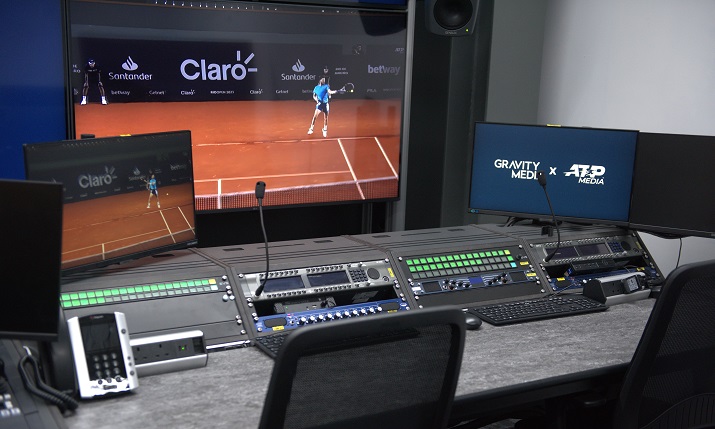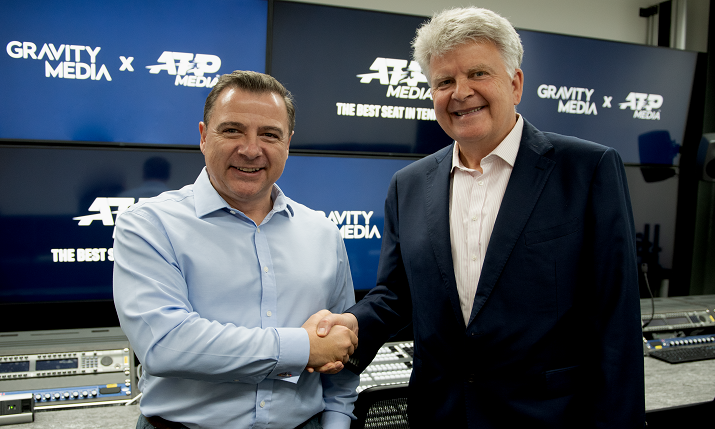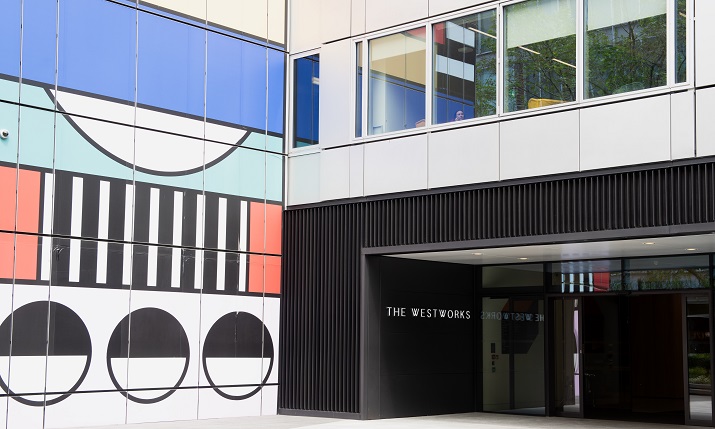Visionary: On technology and expansion with Gravity Media’s John Newton

Gravity Media signed a new long-term partnership with ATP Media to deliver global coverage of over 60 of the ATP Tour’s tennis tournaments, including the ATP Masters 1000s, ATP 500s, ATP 250s and the season-ending Nitto ATP Finals in May this year
Gravity Media has its fingers in so many different pies within the sports, entertainment, production, and facilities industries that it is unsurprising that the company’s founding CEO, John Newton, is often thinking about the “big picture” where his business is heading, and how he can fully utilise all its capabilities.
Newton has a unique all-round view of the industry because, while Gravity Media’s business is based on hardware such as OB services and flypacks, it is also delivering creativity, innovative production solutions and ideas to some of the most high-profile sports and entertainment clients around the world.
Both sides of Newton’s business need tight management. “To be successful, you have to try to evolve and disrupt. If we always do the same thing season after season, we’ll go backwards. So, sometimes we review our services and decide that they are not meeting client needs and we need to upgrade our thinking and approach. Or we study some of the territories and say we’ll never win this fight in that part of the world, so let someone else have it. It means we remain agile and move our capital and our people elsewhere and we’re not afraid of making mistakes.”
The English-born, Australian-resident CEO is at the centre of the privately-owned company and is Gravity Media’s largest shareholder. He began in the industry by founding Gearhouse Broadcast and built up that company’s reputation by supplying high-quality turnkey production facilities and project management for large scale live sports and production events. After several acquisitions, Newton then brought his diverse production brands under the Gravity Media name in 2019 and continued to expand and invest around the world.
“We make money by smartly utilising our assets. The new production centre in Westworks allows us to combine our years of expertise and experience in one location”
Today he sits in his latest multi-million-pound facilities building in London’s White City, which is the company’s sixth English operation. The new Westworks site will be fully functioning later this year as a place for more of his own staff to operate from, as well as a delivering a production base for long-term clients like Formula E and ATP Media amongst others.
Gravity Media is thrilled to be hosting its official launch on Wednesday 5 July 2023, in collaboration with ATP Media and Formula E, welcoming guests and showcasing the latest facility.
Newton comments: “Turnkey style services for long term clients have become a core part of our business. The sports TV world for many broadcasters is based on partnerships built through creative ideas, first-class services, and outsourcing. A rights holder who might do an Olympics every two or four years doesn’t want the long tail of extra overheads. There are also federations like UEFA who want to create their programmes but use someone else’s facilities which is why we have created the Westworks operation.
“All of the Formula E live Grand Prix race broadcasts and ATP Masters 1000s, ATP 500s, ATP 250s and the season-ending Nitto ATP Finals events are produced at Westworks, which allows us to have long term partnerships with clients where we provide an operational service that is hardware-driven but also comes with our own ideas and creativity too.”

Gravity’s John Newton shakes on the deal with Mark Webster from ATP Media
Client partnerships
Newton talks a lot about the importance of close client partnerships, and recurring streams of income with partners who have been with him for more than two successful decades. He believes in a strategy of working together over the long term for the common goal of high-class turnkey production, sports, and entertainment events, and it is this element of the business that inspires him rather than, for example, technology.
“There’s a bit of an arms race going on with technology, even though, the fact is that new tech doesn’t always perform better,” he says. “We’ve got into this idea that we have to have the latest and greatest tech and that’s fine if it adds value. But if we get a request for proposal (RFP) and it’s driven by engineering or a procurement department, it can be very prescriptive and totally ignores the real value delivered through great ideas, a strong creative approach and knowledge built on experience.”
Newton says this issue has become more of a problem in recent years. “An RFP might state the need to supply a certain brand of camera or a particular type of lens, both being of the latest spec or generation. But this can be frustrating as clients don’t always what they really need and why they want the item, and contracts can be won or lost on this detail.”
“Will robotic cameras replace the job of a cameraman? Possibly, I can’t stop that from happening. Can a computer direct a live football match better than our best directors? Not now, but maybe in time”
Despite some irritation with misused technology, Newton is proud of tech innovations by his own company, like the point of view RF cameras his team has put on motor racing cars or those placed in the helmets of cricketers for The Hundred Series.
“The view of a cricket ball coming directly towards you, that’s technology that makes a difference, it’s tech that enhances the viewer’s experience,” he says. “But if a client wants to use the latest generation Sony camera rather than past generation Grass Valley, we know that after you distribute the signal, the viewer is unlikely to notice any difference.”
This argument all boils down to Gravity Media being a business that has a high capital cost and requires competence in fully utilising all its technical assets, production studios, post production suites and so much more hardware and software.
This efficiency is key to Newton’s success, he claims. “The world at the moment is about outsourcing for broadcasters who don’t want an overhead structure, so we have to provide an operational service that is hardware-driven with an overlay of editorial creativity.”
He is highly conscious of the need for returns on each piece of expensive equipment investment. “Like most businesses, we’re under pressure from inflation and interest rates, and it can be a difficult market to work in,” he notes. “We make money by smartly utilising our assets. The new production centre in Westworks allows us to combine our years of expertise and experience in one location.”

Westworks, Gravity Media’s new production centre in London
Remote production
Gravity Media has embraced new technology and workflows which have made remote productions far more feasible. Newton says this is one of the most important technology transitions.
“There’s so much subsidiary sport out there, like college sports in the US. This product can be very successful if you get the business model right”
“When we have Formula E races produced at Westworks, for example, there can be more than one hundred discreet feeds coming in from each race from anywhere in the world and they produce the live programme here. It’s all backhauled rather than being done on site and this kind of remote production means less hotel costs, less per diems, less travel costs and people can be more efficient working from one location.
“There’s a big buzz in the industry about remote production and new tech plays into this because live production is incredibly costly, and we now have a convergence of the old and new worlds which is very IP and IT-centric.”
For all the benefits of trends towards high speed connectivity at sports venues, remote production and automated sports event cameras, Newton still believes in one of Gravity Media’s core offerings; his OB trucks and having people on site.
“I don’t think OBs will be killed off, but they will change. They will just be smaller with fewer people inside. But there will still need to be staff on site to troubleshoot and provide much-required support”.
Revolution of technology
Yet Newton knows he cannot stop human camera operators or maybe even live sports programme directors from being replaced by machines. “It’s a huge topic and debate at the moment, but it’s difficult to hold back the evolution of technology and I don’t think we can do that. Will robotic cameras replace the job of a cameraman? Possibly, I can’t stop that from happening. Can a computer direct a live football match better than our best directors? Not now, but maybe in time.”
There are still new technologies that do excite Newton, such as his cellular bonding software branded as Celbo, a product that has emerged from his team in Australia and enables more efficient remote live streaming. Gravity Media has already successfully used Celbo during coverage in the last Australian summer of golf and cricket.
Newton sees the product as being especially able to focus on coverage of smaller, second tier sporting events which could be another growth area for Gravity Media. “There’s so much subsidiary sport out there, like college sports in the US. This product can be very successful if you get the business model right,” says Newton.
The Celbo software can operate with automated cameras that each provide a different field of view of a sports field. The software stitches the images together and produces a single, high resolution, broadcast quality finished product that can include on-screen graphics and multiple camera replays.
“Now we can send cameras to cricket matches or even golf courses with no cables and no trucks because the software uses RF technology to pick up the images and transmits them straight back to our facility where we remotely produce the show,” says Newton. “The process relies on connectivity and high data rates. You tend to have only 5G in metro areas and less in rural areas, so that’s a restriction right now. But it’s ideal for second tier sports, maybe for schools, colleges, or federations who all want more coverage.”
Providing solutions to problems for second tier sports coverage is what pleases Newton the most, along with having his staff’s knowledge used to its fullest extent. “When you work with top producers, they have a vision of their show and what it should look like. Our teams work with them to help them discover how they can optimise our technology to deliver that vision. This is a great relationship and the idea of giving the right tech to these people is what gets me up in the morning.”
All about John Newton and Gravity
John Newton originally trained for a career as an engineer and now heads a business that boasts 16 offices and 30 OB trucks situated around the world. The company has 500 different teams of people that offer clients everything from live production facilities with studios, speciality cameras to flypacks, outside broadcast units, full post production editing and visual effects services.
The brand now known as Gravity Media was established in 2000 when multiple companies, including – Gearhouse Broadcast, HyperActive Broadcast, Input Media, and Chief Entertainment – were placed under a single brand in 2019.
The company has since made some strategic acquisitions to its portfolio and brought in the Anglo-American private equity fund TowerBrook Capital as a partner in 2016.
Gravity Media brings iconic sporting moments and entertainment to screens around the world, with major clients including federations like UEFA, ATP Media, Formula E and broadcasters such as ITV, BBC, and Netflix amongst many others.

